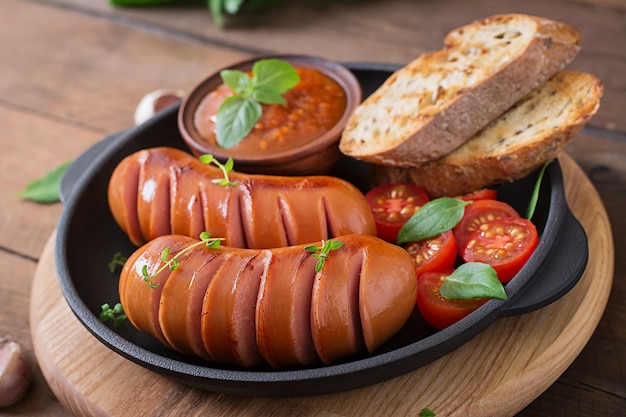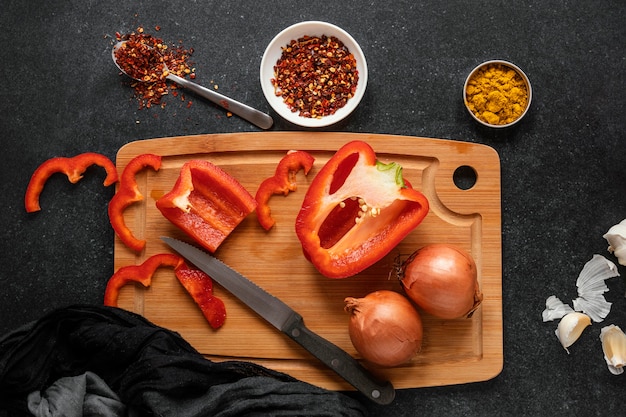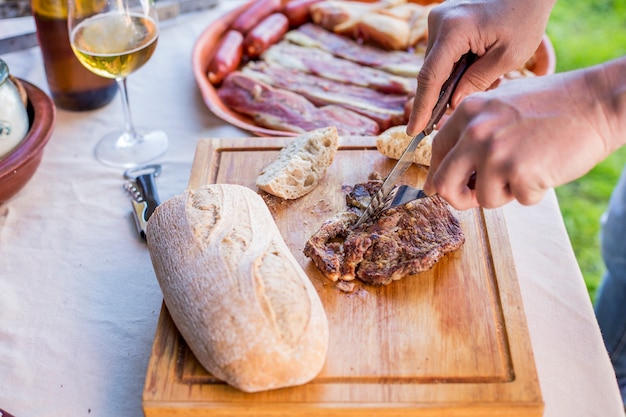You've got your hands on some chorizo, and you're ready to create a culinary masterpiece. But before you get carried away, let's talk about cooking times. Chorizo isn't your average sausage; it's got a unique personality, and getting the timing right is crucial to achieving the perfect flavour and texture. Let me tell you, I've been there - I've overcooked a batch so badly it turned into a tough, dry brick. Not a pleasant experience, I assure you!
But fear not! This guide will be your trusty sidekick in the chorizo kitchen. We'll explore the fascinating world of chorizo, discover its many varieties, and delve into the best cooking methods to unlock its flavour potential. We'll even discuss chorizo safety, because nobody wants a dodgy sausage situation.
Part 1: The Chorizo Journey: From Farm to Fork

From Humble Beginnings: The Chorizo Story
Before we dive into the cooking, let's take a moment to appreciate the history and origin of this beloved sausage. Chorizo traces its roots back to the Iberian Peninsula, specifically Spain and Portugal. Its history is intertwined with the tradition of curing and preserving meat, a practice that dates back centuries. The name "chorizo" is derived from the Spanish word "chori??a," meaning "sausage."
The Heart of Chorizo: The Ingredients
What makes chorizo so special? It's all in the ingredients. The core ingredient is typically pork, although beef, chicken, or turkey can be used. But the true magic lies in the blend of spices and seasonings. Paprika, garlic, and a touch of chili pepper are staples, but regional variations abound. Some chorizo recipes incorporate additional spices like cumin, coriander, or fennel seeds, each adding a unique depth of flavour.
Curing and Smoking: Adding Depth of Flavour
Many types of chorizo are cured and smoked, which adds a rich, smoky flavour and enhances its shelf life. Curing involves using salt and other preservatives to inhibit the growth of bacteria and extend the sausage's longevity. Smoking adds that distinctive smoky aroma and flavour, a hallmark of many traditional chorizo varieties.
Part 2: Exploring the Chorizo Family Tree

The world of chorizo is diverse and fascinating. Let's take a closer look at some of the most popular varieties:
- spanish chorizo: The epitome of chorizo, this iconic sausage is typically made from pork, seasoned with paprika, garlic, and other spices. It often undergoes a curing and smoking process, resulting in a deep, smoky flavour. You'll find Spanish chorizo in both sweet and spicy varieties, so be sure to check the label before you buy.
- portuguese chorizo: This cousin of Spanish chorizo is known for its slightly more subtle flavour profile. It's often a blend of pork and beef, seasoned with paprika, garlic, and occasionally cumin. It's generally less spicy than its Spanish counterpart, but still boasts a unique smoky flavour.
- mexican chorizo: This fiery sausage is a culinary staple in Mexican cuisine. It's typically made from pork, but can also include beef, chicken, or turkey. It's packed with chili peppers, giving it a seriously spicy kick. Mexican chorizo is often crumbled and cooked in a pan, and it's a key ingredient in numerous Mexican dishes.
- Italian Chorizo: While not as commonly known as other varieties, Italian chorizo, often called "salsiccia," deserves a mention. It's usually made with pork, fennel, and other spices, resulting in a milder flavour than Spanish chorizo. It's a versatile ingredient, often used in pasta dishes and other Italian classics.
Each variety of chorizo offers a unique culinary experience, so choose the one that best suits your taste and the dish you're preparing.
Part 3: Mastering the Art of cooking chorizo

Now that we've familiarized ourselves with the chorizo family, let's explore the various methods for cooking this delicious sausage.
Method 1: Pan-Frying: The Classic Approach
This is the most common and straightforward method for cooking chorizo. It's quick, easy, and delivers that perfect crispy exterior we all crave.
Here's how to achieve pan-fried chorizo perfection:
- Heat It Up: Heat a large frying pan over medium heat.
- Add the Chorizo: Add the chorizo to the pan and cook, turning occasionally, until it's browned and crispy on all sides.
- Timing is Key: Depending on the type of chorizo and your preference for doneness, this will take about 5-10 minutes.
- Low and Slow: If using fresh chorizo, you can also cook it over low heat for a longer period, about 15-20 minutes, to render out some of the fat. This will result in a more tender and flavorful chorizo.
- Fat for Flavor: Remove the chorizo from the pan and set aside. You can now use the rendered fat for other cooking, such as sauteing vegetables or making a delicious sauce. Or simply discard it.
Method 2: Baking: A Hands-Off Approach
For a more relaxed cooking experience, baking is your go-to method. It's ideal for larger quantities of chorizo or when you want to avoid the splattering of frying.
Here's how to bake chorizo to perfection:
- Preheat Your Oven: Preheat your oven to 375°F (190°C).
- Prepare the Baking Sheet: Line a baking sheet with parchment paper. This will prevent the chorizo from sticking to the sheet and make cleanup a breeze.
- Arrange the Chorizo: Place the chorizo on the baking sheet, leaving a little space between each piece to allow for even cooking.
- Bake It Up: Bake for 15-20 minutes, or until the chorizo is cooked through and browned. You'll know it's done when it's firm and springy to the touch.
- Add a Touch of Crisp: For a crispy chorizo, you can broil it for a few minutes at the end of cooking time. Just watch it closely to prevent it from burning.
Method 3: Grilling: A Summery Delight
If you're lucky enough to have a grill, why not take your chorizo on a summery adventure? Grilling adds a unique smoky flavour and creates delicious grill marks.
Here's how to grill chorizo like a pro:
- Preheat the Grill: Preheat your grill to medium heat.
- Grill It Up: Place the chorizo on the grill and cook for 5-7 minutes per side, or until it’s cooked through and has nice grill marks.
- Smoky Flavor Boost: If you're feeling adventurous, you can even add some smoky flavour by grilling the chorizo over a wood chip fire. Just soak the wood chips in water for about 30 minutes before adding them to the grill.
Part 4: Decoding Cooking Times: A Guide for Every Occasion
Now, let's get into the nitty-gritty of cooking times. As we've learned, chorizo comes in various forms, each requiring slightly different treatment. Here's a guide to help you find the perfect cooking time for your chorizo.
Spanish Chorizo
Fresh Spanish Chorizo: This type is usually sold raw and requires cooking. Depending on the thickness, it can take anywhere between 8-15 minutes to cook in a pan. You'll know it's done when it's browned all over and firm to the touch.
Cured Spanish Chorizo: This chorizo has already been cured and smoked, so it's technically safe to eat raw. However, many people prefer to cook it slightly to enhance the flavour and texture. A few minutes in a pan or oven is all it needs.
Portuguese Chorizo
Fresh Portuguese Chorizo: This type is often sold raw and needs to be cooked through. Pan-frying is the usual approach, and it will take around 8-12 minutes depending on the thickness.
Cured Portuguese Chorizo: You can enjoy this one as is, or give it a quick sear for added flavour.
Mexican Chorizo
Fresh Mexican Chorizo: This is usually sold raw and needs to be cooked through. It tends to be quite fatty, so it needs to be cooked until the fat is rendered out and the chorizo is browned and crispy. This takes about 10-15 minutes in a pan.
Cured Mexican Chorizo: This is often pre-cooked, but it can still benefit from a quick saute to enhance its flavour.
Italian Chorizo (Salsiccia)
Fresh Italian Chorizo: This is usually sold raw and needs to be cooked through. Pan-frying is the most popular method. It will take around 10-15 minutes depending on the thickness.
Cured Italian Chorizo: This is often already cooked and just needs a quick heat-up.
Part 5: Spotting Doneness: The Telltale Signs
Now, how do you know when your chorizo is ready to be devoured? Keep an eye out for these telltale signs:
- Colour: The chorizo should be browned all over. This indicates that it has been cooked through and has achieved that delicious, crispy exterior.
- Texture: The chorizo should be firm and springy to the touch. It shouldn't feel squishy or raw.
- internal temperature: This is the most reliable way to check for doneness. The internal temperature should reach at least 160°F (71°C). You can use a meat thermometer to check.
Part 6: Avoiding Overcooked Mishaps
Remember that overcooked chorizo can become dry and tough. It will also lose some of its delicious flavour. So keep a watchful eye on your chorizo and take it off the heat as soon as it reaches the desired doneness. Trust your senses, and don't be afraid to taste-test along the way!
Part 7: Chorizo Safety: Protecting Your Sausage
Nobody wants a dodgy sausage situation, right? Here's a quick checklist to ensure your chorizo is safe to eat:
- Storage: Keep your chorizo refrigerated at 40°F (4°C) or below. If it's cured, it can be stored in the fridge for several weeks, but fresh chorizo should be used within a few days.
- Thawing: If you're thawing frozen chorizo, do it in the refrigerator, not at room temperature. This helps prevent bacterial growth and ensures the chorizo thaws evenly.
- Cooking: Always cook your chorizo thoroughly, reaching an internal temperature of at least 160°F (71°C). This ensures that any harmful bacteria are killed.
- Don't Refreeze: Once you've thawed frozen chorizo, don't refreeze it. Refreezing can compromise the quality and safety of the chorizo.
- Expiration Dates: Always check the expiration date on your chorizo. This will give you a good indication of the chorizo's freshness and safety.
Part 8: Unleashing the Flavour: Beyond the Basics
Now that you've got the basics down, let's talk about some creative ways to use chorizo. It's more than just a sausage, it's a culinary superstar!
- Spanish Tortilla: A classic Spanish dish, it's a thick omelet made with potatoes and chorizo. The chorizo adds a rich, smoky flavour and a satisfyingly crispy texture.
- chorizo and bean stew: A hearty and comforting dish that's perfect for a cold evening. The chorizo adds a spicy kick and a delicious depth of flavour to the stew.
- Chorizo and Manchego Paella: A vibrant and flavorful rice dish with chorizo, seafood, and Manchego cheese. The chorizo adds a smoky depth and a touch of spice, perfectly complementing the other ingredients.
- Chorizo and chickpea salad: A light and refreshing salad with chorizo, chickpeas, and a lemon dressing. The chorizo adds a smoky flavour and a satisfyingly chewy texture to the salad.
- chorizo and potato hash: A rustic and flavorful hash with chorizo, potatoes, and onions. The chorizo adds a spicy kick and a delicious depth of flavour to the hash.
- Chorizo and Pepper Skewers: A colourful and delicious skewer with chorizo and peppers, grilled to perfection. The chorizo adds a smoky flavour and a satisfyingly chewy texture to the skewers.
- Chorizo Pizza: A unique and satisfying pizza with chorizo, peppers, and onions. The chorizo adds a spicy kick and a delicious depth of flavour to the pizza.
- Chorizo and Apple sausage rolls: A sweet and savoury sausage roll with chorizo and apple. The chorizo adds a smoky flavour and a satisfyingly chewy texture to the sausage rolls.
- Chorizo stuffed peppers: A hearty and flavorful dish with chorizo stuffed into bell peppers. The chorizo adds a spicy kick and a delicious depth of flavour to the stuffed peppers.
The possibilities are endless, so get creative and explore the wonderful world of chorizo!
Part 9: FAQs: Your Chorizo Questions Answered
Now, let's tackle some of the most common questions you might have about cooking chorizo:
FAQs
| Question | Answer |
|---|---|
| Can I cook chorizo from frozen? | Yes, you can cook chorizo from frozen. However, it will take longer than cooking from thawed. Just be sure to adjust your cooking time accordingly. For example, if you're pan-frying frozen chorizo, it may take 10-15 minutes instead of the usual 5-10 minutes. Also, be sure to check the internal temperature to ensure it's cooked through. |
| Can I eat chorizo raw? | Cured chorizo is often eaten raw, as the curing process inhibits bacterial growth. However, fresh chorizo needs to be cooked through. It's best to err on the side of caution and cook all chorizo, even if it's cured. |
| What happens if I overcook chorizo? | Overcooked chorizo can become dry and tough. It will also lose some of its flavor. The key is to cook it until it's browned and firm to the touch, but not overdone. |
| How can I tell if chorizo is bad? | Bad chorizo will have an off smell or taste. It may also be slimy or discolored. If you're unsure, it's best to throw it away. |
| How long can I keep chorizo in the fridge? | Cured chorizo can be kept in the fridge for several weeks. Fresh chorizo should be used within a few days. |
And there you have it, folks! The complete guide to cooking chorizo. Now go forth, conquer the kitchen, and enjoy those delicious, spicy sausages!
Everyone is watching

Corn on the Cob: The Ultimate Guide to Perfectly Cooked Ears
Healthy MealsAh, corn on the cob. Just the name evokes images of sunny days, barbecues, and that sweet, juicy flavour that ...

Perfect Pork Roast Oven Cooking Time: A Guide to Delicious Results
Healthy MealsThere's something truly satisfying about a perfectly roasted pork. The aroma alone is enough to make your mout...

Scallops: The Ultimate Guide to Perfect Cooking
Healthy MealsAh, scallops. Those delicate, sweet, and utterly delicious morsels of the sea. They hold a special place in my...

Ham Cooking Time: How Long to Bake, Smoke, or Boil a Delicious Ham
Healthy MealsAh, ham. It's a classic, isn't it? A real crowd-pleaser, especially around holidays. And when done right, it'...

Spaghetti Squash: The Ultimate Guide to Cooking and Serving
Healthy MealsRemember that time you saw spaghetti squash at the supermarket, looking all bumpy and strange, and thought, "W...
